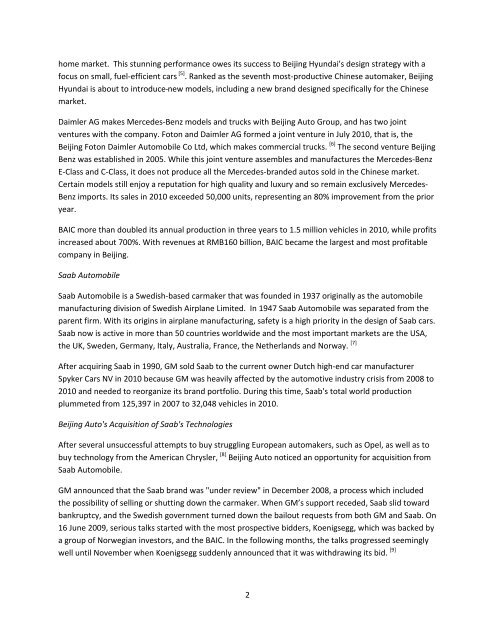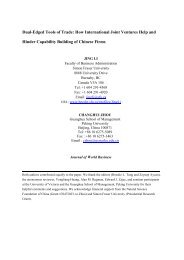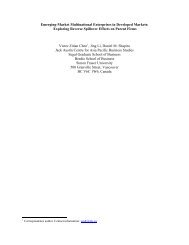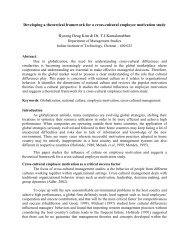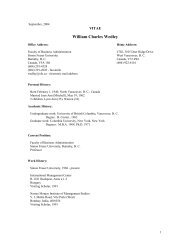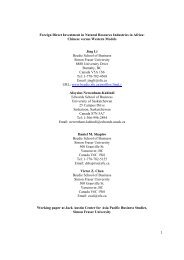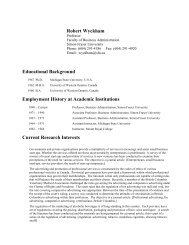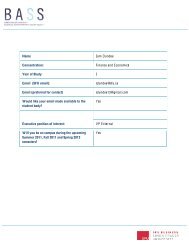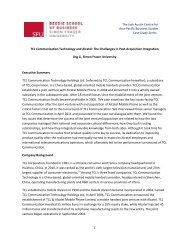1 The Jack Austin Centre For - Beedie School of Business - Simon ...
1 The Jack Austin Centre For - Beedie School of Business - Simon ...
1 The Jack Austin Centre For - Beedie School of Business - Simon ...
You also want an ePaper? Increase the reach of your titles
YUMPU automatically turns print PDFs into web optimized ePapers that Google loves.
home market. This stunning performance owes its success to Beijing Hyundai's design strategy with a<br />
focus on small, fuel-efficient cars [5] . Ranked as the seventh most-productive Chinese automaker, Beijing<br />
Hyundai is about to introduce new models, including a new brand designed specifically for the Chinese<br />
market.<br />
Daimler AG makes Mercedes-Benz models and trucks with Beijing Auto Group, and has two joint<br />
ventures with the company. Foton and Daimler AG formed a joint venture in July 2010, that is, the<br />
Beijing Foton Daimler Automobile Co Ltd, which makes commercial trucks. [6] <strong>The</strong> second venture Beijing<br />
Benz was established in 2005. While this joint venture assembles and manufactures the Mercedes-Benz<br />
E-Class and C-Class, it does not produce all the Mercedes-branded autos sold in the Chinese market.<br />
Certain models still enjoy a reputation for high quality and luxury and so remain exclusively Mercedes-<br />
Benz imports. Its sales in 2010 exceeded 50,000 units, representing an 80% improvement from the prior<br />
year.<br />
BAIC more than doubled its annual production in three years to 1.5 million vehicles in 2010, while pr<strong>of</strong>its<br />
increased about 700%. With revenues at RMB160 billion, BAIC became the largest and most pr<strong>of</strong>itable<br />
company in Beijing.<br />
Saab Automobile<br />
Saab Automobile is a Swedish-based carmaker that was founded in 1937 originally as the automobile<br />
manufacturing division <strong>of</strong> Swedish Airplane Limited. In 1947 Saab Automobile was separated from the<br />
parent firm. With its origins in airplane manufacturing, safety is a high priority in the design <strong>of</strong> Saab cars.<br />
Saab now is active in more than 50 countries worldwide and the most important markets are the USA,<br />
the UK, Sweden, Germany, Italy, Australia, France, the Netherlands and Norway. [7]<br />
After acquiring Saab in 1990, GM sold Saab to the current owner Dutch high-end car manufacturer<br />
Spyker Cars NV in 2010 because GM was heavily affected by the automotive industry crisis from 2008 to<br />
2010 and needed to reorganize its brand portfolio. During this time, Saab's total world production<br />
plummeted from 125,397 in 2007 to 32,048 vehicles in 2010.<br />
Beijing Auto's Acquisition <strong>of</strong> Saab's Technologies<br />
After several unsuccessful attempts to buy struggling European automakers, such as Opel, as well as to<br />
buy technology from the American Chrysler, [8] Beijing Auto noticed an opportunity for acquisition from<br />
Saab Automobile.<br />
GM announced that the Saab brand was "under review" in December 2008, a process which included<br />
the possibility <strong>of</strong> selling or shutting down the carmaker. When GM’s support receded, Saab slid toward<br />
bankruptcy, and the Swedish government turned down the bailout requests from both GM and Saab. On<br />
16 June 2009, serious talks started with the most prospective bidders, Koenigsegg, which was backed by<br />
a group <strong>of</strong> Norwegian investors, and the BAIC. In the following months, the talks progressed seemingly<br />
well until November when Koenigsegg suddenly announced that it was withdrawing its bid. [9]<br />
2


